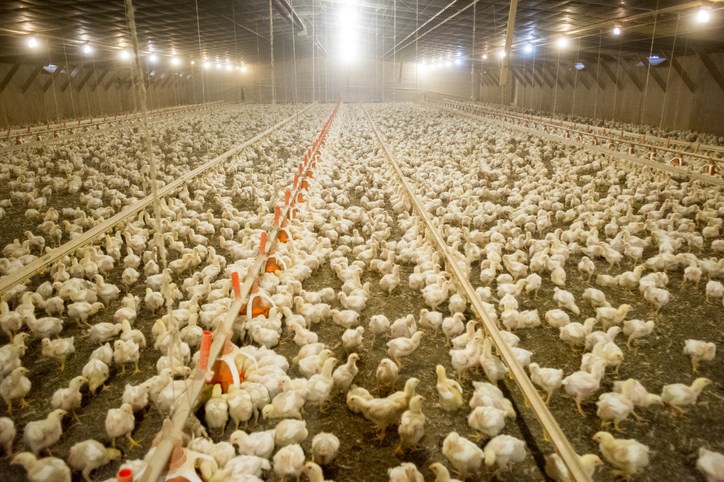The heat dome that scorched British Columbia, killing at least 569 people and an untold number of wildlife, has now been linked to hundreds of thousands of farm animal deaths.
At least 651,000 farm animals were killed between June 24 and June 30, according to several industry groups which disclosed the animal mortality data in freedom-of-information requests.
Camille Labchuk, lawyer and executive director of the advocacy group Animal Justice, obtained data on excess deaths for chicks, egg-laying hens, broiler chickens and turkeys. Industry groups representing dairy cows and hogs said they did not keep such records.
“Farmers do lose birds to injury, illness or predation on a normal basis,” says BC Egg Marketing Board spokesperson Amanda Brittain. “But it would be a drop in the bucket compared to what was lost during the heat dome.”
BC Egg producers, for example, lost 145,000 hens, or four per cent of all laying hens in production that week, confirms Brittain.
There’s a reason fowl were hit hard. Birds can’t sweat, which makes them particularly vulnerable to extreme heat. When temperatures hit 41 C, no amount of feather-ruffling can regulate their temperature, so they are forced to cool down with water, shade or the occasional breeze. In the Fraser Valley, Brittain says temperatures surpassed 43 C for two days straight.
Wild birds suffered, too. Wildlife rehabilitation centres — from Oregon to B.C. — reported starving and dehydrated baby raptors to escape the late June heat. Often contained to large poultry barns, domesticated fowl faced soaring indoor temperatures.
Stefanie Nelson, executive director of the BC Broiler Hatching Egg Commission, says she worked up to 20 hours a day during the last week of June. Moving from one Fraser Valley farm to another, she would share tips on how to keep the animals alive.
She says farmers were setting up sprinklers on rooftops and spraying barn walls with hoses and pressure washers, anything to keep the heat off the structure. Inside, farmers with tunnel ventilators could draw air in from outside. Cooling pads, meanwhile, provided a kind of “air conditioning for chickens.” But in many cases, that wasn’t enough.
CALLS FOR MORE OVERSIGHT
For Labchuk of Animal Justice, the death toll lays bare a farming sector without the necessary oversight to ensure animal welfare.
She points to B.C.'s , which says farmers — or anyone for that matter — are responsible for “protecting the animal from circumstances that are likely to cause the animal to be in distress.”
“I think these producers clearly failed in this obligation,” says Labchuk.
The B.C. government, she says, currently relies on the SPCA to investigate complaints of animal cruelty or abuse. But with limited resources, Labchuck says the organization is often pushed to focus on companion animals like cats or dogs.
BC SPCA chief prevention and enforcement officer Marcie Moriarty tells Glacier Media she hasn’t received any complaints of farm animal cruelty related to the heat wave.
Even if something were to come forward, she says the evidence is now gone, and it would be highly unlikely for a case to pursue charges.
The BC SPCA has 34 special provincial constables to respond to 8,000 animal cruelty investigations a year. Going forward, the organization is advocating for the B.C. government to set up a third-party auditing process to proactively check on the thousands of farms across the province.
“Going forward, producers should take steps to respond,” says Moriarty. “This should not be looked at as an unforeseen event, given climate change.”
GUARDING FOOD FROM CLIMATE CHANGE
With more heat waves, flooding and drought on the horizon, Labchuk says it’s time to figure out how to ensure the province has a lasting and safe source of food.
“The elephant in the room is transferring to a new food system,” says Labchuck. “It’s going to be increasingly difficult to protect these animals going forward.”
Instead of putting pressure on farmers to prioritize producing the lowest-cost meat and eggs, the province needs to help industry transition to more regional food systems, says Kent Mullinix, director of Kwantlen Polytechnic University’s Institute for Sustainable Food Systems.
COVID-19 outbreaks at poultry and meat plants have shown how unstable a food system can be that prioritizes “mega-operations,” says Mullinix.
Advocates of a regional food system say more small producers growing a wider variety of food can sustain the shocks of a pandemic, drought and flooding. If one farmer fails, the system holds together. Food is then sold directly to people in the area at farmers' markets or through weekly veggie-box programs without a middleman taking a cut.
“I’m seeing a significant change, a palpable understanding that putting all our eggs in the global industrial basket probably isn’t too smart,” says Mullinix, pointing to a 20-year drought gripping much of the American West.
“We have been so remiss in curtailing greenhouse gas emissions, it is inevitable that many of these major food production areas around the world, including California, will face significant collapse.”
Mullinix is quick to say he doesn’t know a single farmer who doesn’t want to do a good job or wants animals to suffer. At the same time, he says with such deadly weather events expected to return more often in the coming decades, routinely subjecting animals to extreme heat “should give us pause to think.”
For industry group representatives like Brittain, looking south is not all about doom and gloom. She says it’s time to learn from farmers in parts of the United States already experiencing routinely hot temperatures.
“With climate change, I think all of agriculture is recognizing that heat waves like that are going to be normal,” says Brittain.
“We have to have those wider conversations.”
Stefan Labbé is a solutions journalist. That means he covers how people are responding to problems linked to climate change — from housing to energy and everything in between. Have a story idea? Get in touch. Email [email protected].





